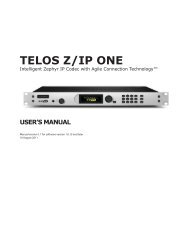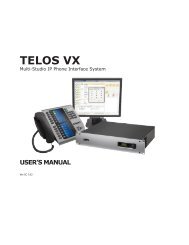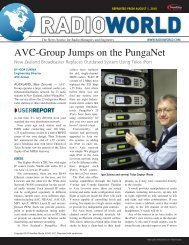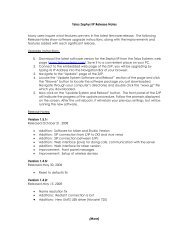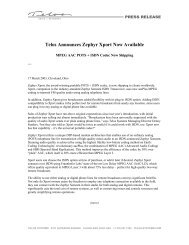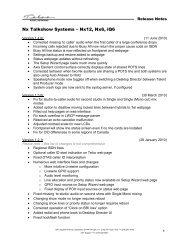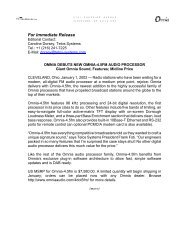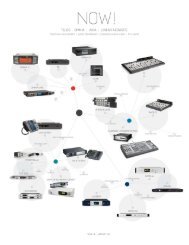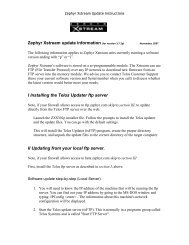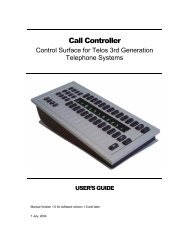Hx1-Hx2 Manual-1.4.1 - Telos
Hx1-Hx2 Manual-1.4.1 - Telos
Hx1-Hx2 Manual-1.4.1 - Telos
Create successful ePaper yourself
Turn your PDF publications into a flip-book with our unique Google optimized e-Paper software.
A6 | appendix 1<br />
DID Extension or DID station - A specific phone within a PBX which can be called from the<br />
public telephone network without going through an attendant or auto-attendant.<br />
DID Number- A phone number used to route calls from the telephone network to a specific<br />
phone in a PBX (the DID extension). DID requires special DID trunks or ISDN PRI “twoway<br />
DID” trunks. Blocks of DID numbers (typically 10 or 20, sometimes higher) are purchased<br />
from the LEC or CLEC for use on the PBX. The number of DID numbers usually substantially<br />
exceeds the number of trunks in the system.<br />
DID Trunk- A Direct Inward Dialing Trunk. A trunk (channel) which can only receive calls. A<br />
group of telephone numbers (DID numbers) are associated with a given trunk group, however<br />
there is no one-to-one correspondence between the individual channels and these numbers. The<br />
PBX uses the DID number given it by the phone company to route the channel to the correct<br />
DID extension within the PBX. This allows some or all PBX stations to receive calls directly<br />
without going through an attendant (or auto attendant). Note that there are usually more DID<br />
numbers than there are DID trunks. See DID number and DID extension.<br />
Direct Inward Dialing- See DID.<br />
Directory Number (USA & Canada)- Your seven digit telephone number (without the area<br />
code), as found in the telephone directory.<br />
DMS-100 – Nortel’s very popular central office switch provides local POTS service and connectivity<br />
to the public switched telephone network. It is used widely in countries throughout the<br />
world.<br />
DNIS- Dialed Number Identification Service- A service, typically offered by a long distance<br />
company on 800 lines, that provides the number dialed by the caller. This allows a caller to<br />
receive specific treatment depending on the number dialed.<br />
DP - Dial Pulse. A method of sending address information by either 1) Causing brief interruptions<br />
in loop current or 2) Causing brief changes of state of a bit on a digital circuit using<br />
Channel Associated Signaling. In other words, “rotary” or “pulse” dialing. See also DTMF and<br />
CAS.<br />
“Dry Loop” or “Dry Pair” DSL – DSL service offered without a POTS line to carry it. These<br />
circuits often cost less because many of the taxes, “regulatory recovery fees” and other nonsense<br />
charges apply only to POTS phone service. Also, many customers wish to use VoIP with their<br />
DSL and have no use for the expensive POTS phone once required to be ordered with DSL<br />
service.<br />
DSØ- Digital Signal Level Zero. The smallest unit of measure of the standard rate hierarchy<br />
used by the Telcos (i.e. all other rates are a multiple of the DSØ rate. For example, the T1 rate is<br />
24 times the DSØ rate and the E1 rate is 32 times the DSØ rate). 64 kbps. See also B channel.<br />
DS1-Digital Signal Level 1. The second level up the digital rate hierarchy used by the Telcos.<br />
This is 24 times the DSØ rate for a total of 1.544 mbps. See DSØ. See also T1.<br />
DS2-Digital Signal Level 2. Data rate of 6.312 mbps (4 times the DS1 rate). See DSØ and<br />
DS1.<br />
DS3-Digital Signal Level 3. Data rate of 43.232 mbps (28 times the DS1 rate). See DSØ and<br />
DS1.<br />
DSL- Digital Subscriber Line. Traditionally refers to an ISDN circuit or sometimes a T1 line,<br />
although the term is also frequently used to mean the next generation beyond ISDN. Sometimes<br />
xDSL is used to indicate that the writer is referring to any of a number of emerging DSL<br />
technologies.



